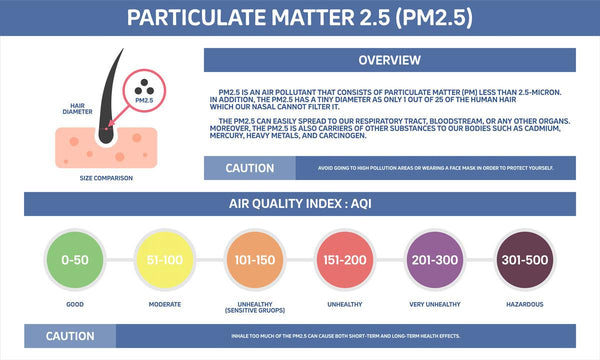
Pollution crisis: fact or fiction?
The majority of South Africa’s electricity is generated from coal, which mostly comes from the coalfields in eMalahleni and the Highveld. This area is responsible for around 84% of South Africa's production, and subsequently, it is the second worst sulphur dioxide pollution hotspot in the world. When it comes to air pollution, we can definitely say there is a pollution crisis, and it affects us all.
Greenpeace states that the burning of coal “puts harmful toxins into the air, such as fine particulate matter (PM), nitrogen oxides, including nitrogen dioxide, sulphur dioxide, lead, mercury, and other heavy metals.” PM2.5 - particles with a diameter of less than 2.5 micrometres - is one of the most dangerous pollutants in the air. Coal combustion emits microscopic sulphate particles that are small enough to enter the bloodstream. PM2.5 exposure has been linked to a slew of health issues, such as respiratory system inflammation and irritation, resulting in coughing, throat irritation, and breathing difficulties. It can impair lung function, exacerbate asthma attacks, and exacerbate pre-existing heart disease in vulnerable people.
When these pollutants mix with water and oxygen in the atmosphere and fall to earth as acid rain, it damages plants by changing soil composition; degrades water quality in rivers, lakes and streams; damages crops; and can even cause buildings and monuments to decay.

What effects does it have on your health?
Air pollution has a wide range of long- and short-term health effects. Short-term health effects can range from temporary pneumonia or bronchitis to general discomfort such as nose, throat, eye, or skin irritation. The long-term consequences are far more serious and can even be fatal. It is linked to heart disease, lung cancer, and respiratory diseases like emphysema.
The nation’s coal belt stretches from the east of Pretoria and Johannesburg through to eMalahleni, which means "the place of coal". The area has 12 Eskom coal fired power stations and some Sasol petrochemical plants.
The effects of the pollution on the health of the marginalised and vulnerable communities living in the nation’s coal belt is undeniable. A 2019 study conducted by the Council for Scientific and Industrial Research (CSIR) revealed that more than 5 000 South Africans die annually in the nation's coal belt due to poor air quality. And many of the children living in that region have persistent asthma.
What can be done?
Coal power is a contentious issue in South Africa. The coal industry is the world’s fifth largest and it employs 90 000 miners. In a country with a national unemployment rate of 34,5% and 63,9% for those aged 15-24, we can’t simply shut down our coal industry. The government needs to tread lightly and address the serious issue of air pollution without affecting the poor who are already desperate for job opportunities.
In March of 2022, the High Court ruled that Mpumalanga's unsafe level of air pollution violates residents' section 24(a) constitutional right to a healthy and safe environment, as well as other constitutional rights. The environment minister has been given a year to enforce a clean air plan. The government, according to the complaint, failed to carry out its 2012 plan to improve air quality in Mpumalanga. Let us hope that it will be more concerned and diligent this time round.
Despite the fact that the amount of clean energy produced in South Africa has steadily increased, it still accounts for only about 14% of total electricity production. There are 33 wind farms at various stages of development throughout South Africa, with generators equalling 3,672MW installed capacity, five hydropower stations with an installed capacity of 3,485 MW, and a number of solar farms mostly in the Northern Cape with an installed capacity of more than 2,323 MW. Dr. Bischof-Niemz head of energy at the CSIR, says that renewable energy is quite new for South Africa but is developing rapidly.
Keeping your air clean at home
While Solenco can't control the outside air, we can control your indoor air at home and in the workplace. Air purifiers with a HEPA (High Efficiency Particulate Arrestor) filter are effective at removing indoor pollutants from traffic and other PM2.5 sources. If the level of PM2.5 goes to or above 35 μg/m3 during a 24-hour period, the air is considered unhealthy and can cause problems for people who already have breathing problems, such as asthma.
The Solenco CF8500 Air Purifier is equipped with a medical grade H13 HEPA filter that captures up to 99,975% of particles that are 0.1 microns in diameter. The H13 HEPA filter is medical grade making it an even more efficient and safer option over a standard HEPA filter. The CF8500 also has a PCO to destroy particles as small as 0.001 microns, a UVC light that kills viruses and bacteria, and an anti-viral filter that is effective at reducing SARS-CoV-2 infection. This air purifier is recommended for rooms up to 45m2 such as your personal spaces including offices, bedrooms, dental surgeries, doctor’s offices and many more.
The Solenco CF8608 Smart Air Purifier has an auto function with a PM2.5 air quality sensor and display. The purifier also comes with a medical grade H13 HEPA filter, and a UV light and PCO that destroy virus and bacteria particles as small as 0,001 microns. With a somewhat bigger capacity, it is recommended for rooms up to 50m2.
For more information on air purifiers, chat to the team at Solenco.

Leave a comment